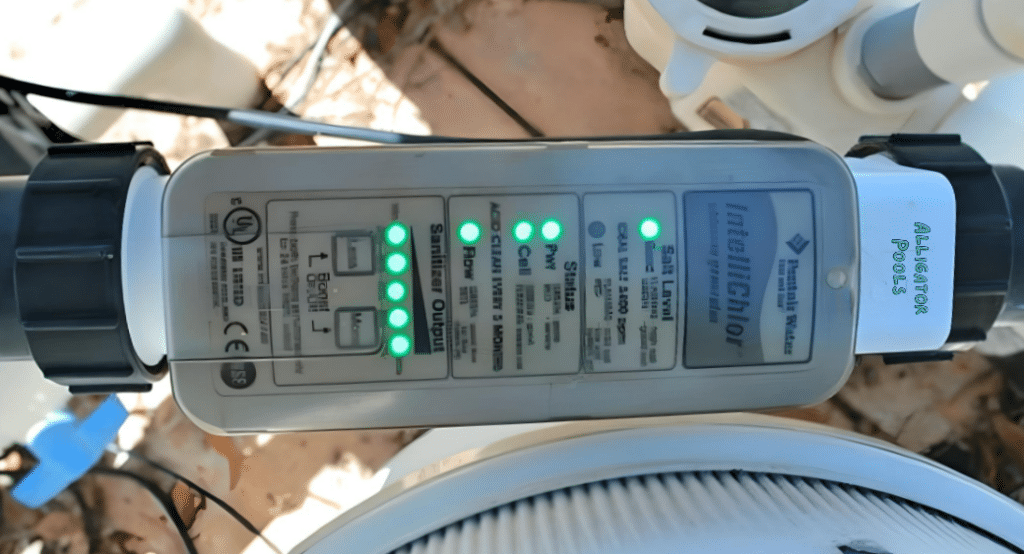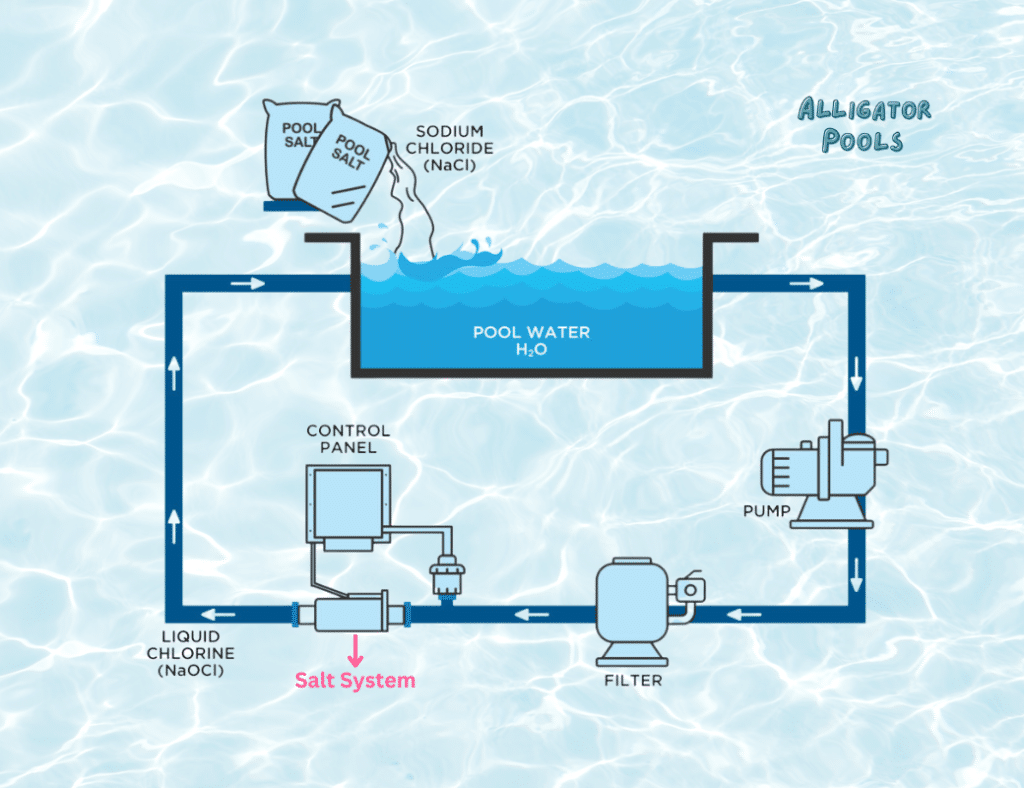Home » Pool Cleaning Florida » Pool Cleaning Kendall » BLOG: Salt Systems Kendall

Saltwater pools, especially those with Saltwater Chlorinators and Salt Systems, are increasingly popular in places like Kendall. Their rise in popularity is due to the health benefits they offer swimmers and their effectiveness as an alternative method to pool maintenance. In this article, we’ll explain how salt chlorine generators work and the benefits of incorporating one into your pool’s maintenance regime.
We aim to enlighten you on the key points to consider when selecting a new salt chlorine generator for your pool in Kendall.
As a leading provider of pool cleaning services in Kendall, Alligator Pools is at the forefront of installing and maintaining Salt Systems and Saltwater Pool Systems. Understanding these systems is crucial for any pool owner considering a switch to a saltwater system.
We’re here to guide you through every step, from choosing the right Saltwater Chlorine Generator to ongoing pool maintenance in Kendall. Let’s dive into the essentials of saltwater chlorination and how it can revolutionize your swimming experience.
A Salt Chlorinator System, commonly known in Kendall as a Saltwater Chlorinator, Saltwater Chlorine Generator, or simply a Salt System, is a sophisticated method of sanitizing your pool. These systems are often referred to by various names, which can be confusing when you’re researching the best option for your pool.
Essentially, they are all about a pool’s sanitization process using a generator that converts salt into chlorine. The beauty of Saltwater Pool Systems lies in their ability to produce chlorine at much lower levels compared to traditional chlorine pools. This not only ensures a cleaner and more well-maintained pool but also offers significant benefits for your skin, health, and swimwear.
Delving deeper into the science behind Salt Chlorinator Systems, it’s fascinating to explore the role of salinity in pool maintenance. In Kendall and similar climates, where pools are a staple, understanding salinity is key. Saltwater systems use a specific concentration of salt to effectively generate chlorine. This concentration is much lower than seawater, making it gentle on the skin and eyes. The process is a perfect blend of nature and technology, using natural salt in a way that minimizes harsh chemicals, yet effectively keeps pools clean and hygienic. This understanding of salinity is crucial for pool owners considering a transition to a Saltwater Pool System.
Saltwater pools, increasingly preferred by residents in Kendall, offer numerous benefits over traditional chlorine pools. Firstly, they are much gentler on your skin, and even more noticeably, they are kinder to your swimwear. Many Salt Systems owners report a significant reduction in the typical chlorine smell both in and around the pool.
Additionally, these systems excel at distributing chlorine evenly throughout your pool. This consistency not only minimizes ‘shock’ treatments but also reduces wear and tear on the pool’s surface. With a control panel, you can effortlessly manage the chlorine levels in your pool, though regular checks of the pool’s water chemistry are still necessary.
Moreover, Salt Chlorine Generators simplify maintenance routines. Thanks to consistent chlorine levels, there’s a lower chance for algae and bacteria to thrive, which means less cleaning and upkeep for you. Lastly, these systems eliminate the need to handle heavy chlorine jugs, although they do require a steady supply of salt to function optimally.
For Kendall pool owners, understanding how Salt Systems for pools work is essential. These systems, including Saltwater Chlorinators and Saltwater Pool Systems, operate on a simple yet ingenious principle. The process begins with salt (sodium chloride) added to the pool water. The salt chlorine generator, which is the heart of the system, then uses electrolysis to break down the salt.
During electrolysis, an electrical current pass-through saltwater, splitting the salt molecules into sodium and chlorine. The chlorine generated in this way sanitizes the pool, keeping it free from algae and bacteria. This method of chlorine production is what sets apart Salt Systems from traditional chlorine pools. It’s an efficient and eco-friendly approach that not only keeps your pool water clean but also ensures a more natural and comfortable swimming environment.

An interesting aspect of Saltwater Pool Systems, especially relevant for pool owners in Kendall, is the comparison of their salinity levels to that of ocean water. Saltwater pools maintain a salinity level significantly lower than that of the ocean. Typically, the ocean’s salinity is about 35,000 parts per million (ppm), whereas a saltwater pool’s salinity is usually set around 3,000 to 5,000 ppm. This lower concentration makes the pool water gentler on the skin and eyes, providing a more comfortable swimming experience.
It’s this balance of salinity that allows Salt Systems, including Saltwater Chlorine Generators and Saltwater Pool Systems, to efficiently generate chlorine while ensuring the water remains mild and more natural compared to traditional chlorinated pools. Understanding this salinity difference is crucial for Kendall residents considering a saltwater system, as it highlights the system’s effectiveness in creating a pleasant swimming environment without the harshness of the ocean’s salt levels.
In Kendall, where pool usage can vary with the seasons, understanding the chlorine production time of Salt Systems is essential.
It should also be noted that each manufacturer’s system may vary in terms of operation and performance. That said, Salt Chlorinators most commonly operate only when water is flowing. This means, the run time is directly linked to your pool pump’s operation. Typically, pool pumps run about 8-12 hours a day, though this can increase during the hot summer months or decrease in the cooler winter period.
Most Saltwater Chlorine Generators have an adjustable output setting, which controls the rate of chlorine production. For instance, if the salt system’s output is set to 50% and it runs for 8 hours, it will produce chlorine for approximately 4 hours. This flexibility allows pool owners in Kendall to effectively manage their pool’s chlorine levels, ensuring optimal sanitization while adapting to different usage patterns throughout the year.
Contrary to common belief, Saltwater Pools in Kendall and elsewhere require regular maintenance, just like any other pool. It’s vital to consistently monitor and maintain the chemical levels in your pool to ensure it stays clean and healthy. Additionally, your Saltwater Chlorine Generator needs periodic inspection. Over time, these systems can develop calcium buildup, which can affect their functionality.
For Kendall residents seeking expert pool cleaning service, Alligator Pools offers comprehensive services tailored to Salt Systems. Whether it’s adjusting your Pool Salt System, cleaning, or routine checks, our team ensures your saltwater pool remains in pristine condition. Remember, regular maintenance is the key to the longevity and efficiency of your Saltwater Pool System.
The Salt Chlorine Generator, an essential component of Saltwater Systems, comprises two main parts: the cell and the control board.
The cell is the crucial part where the saltwater is converted into chlorine. It contains a specialized blade, often coated with ruthenium or iridium, allowing water to seamlessly flow through and facilitate the chlorine generation process.
The control board, often referred to as the system’s ‘brain,’ manages and regulates the cell’s function. It ensures the pool’s chlorine levels are consistently balanced, keeping your swimming environment safe and pleasant.
Recently, many Salt Systems have integrated features for connection to pool automation systems. This modern addition allows for remote monitoring and control, often via a mobile device, enhancing convenience and efficiency in pool maintenance.
In conclusion, the shift towards Saltwater Chlorinators represents a significant advancement in pool maintenance in Kendall. From reducing skin and swimwear irritation to providing a more natural swimming environment, the benefits of Salt Systems are clear.
Understanding the mechanics, maintenance, and advantages of Salt Chlorine Generators empowers pool owners to make informed decisions for a healthier, more sustainable pool experience.
Alligator Pools stands ready to assist you with our pool cleaning service or pool maintenance service in Kendall. Remember, the right Saltwater Pool System not only enhances your swimming experience but also contributes to the longevity and ease of maintenance of your pool.